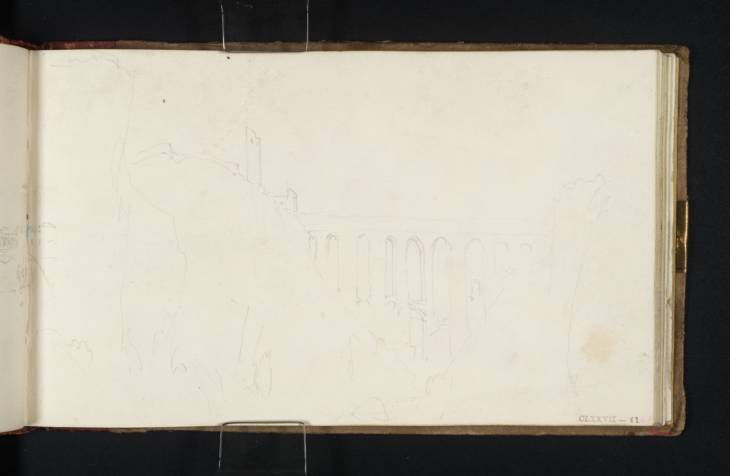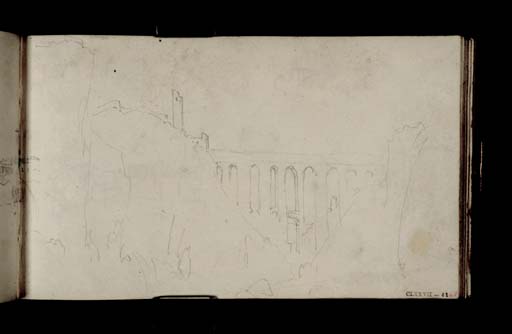Joseph Mallord William Turner The Ponte delle Torri, Spoleto from the Valley 1819
Image 1 of 2
Joseph Mallord William Turner,
The Ponte delle Torri, Spoleto from the Valley
1819
Joseph Mallord William Turner 1775–1851
Folio 41 Recto:
The Ponte delle Torri, Spoleto from the Valley 1819
D14732
Turner Bequest CLXXVII 41
Turner Bequest CLXXVII 41
Pencil on white wove paper, 110 x 186 mm
Inscribed by John Ruskin in red ink ‘41’ bottom right
Stamped in black ‘CLXXVII 41’ bottom right
Inscribed by John Ruskin in red ink ‘41’ bottom right
Stamped in black ‘CLXXVII 41’ bottom right
Accepted by the nation as part of the Turner Bequest 1856
References
1909
A.J. Finberg, A Complete Inventory of the Drawings of the Turner Bequest, London 1909, vol.I, p.522, as ‘Do. [Spoleto.]’.
1968
Giovanni Carandente, ‘Un Viaggio di Turner in Umbria’, Spoletium: Rivista di arte, storia e cultura, no.13, April 1968, p.20, reproduced p.16 fig.6, as ‘Il ponte delle Torri a Spoleto’.
1972
Werner Haftmann, Andrew Wilton, Henning Bock and others, J.M.W. Turner: Gemälde Aquarelle, exhibition catalogue, Nationalgalerie Staatliche Museen Preußischer Kulturbesitz, Berlin 1972, p.114.
1975
Graham Reynolds, Turner 1775–1851: zhivopis', risunok, akvarel', exhibition catalogue, Hermitage Museum, Leningrad 1975, p.48.
1982
Evelyn Joll and Martin Butlin, L’opera completa di Turner 1830–1851, Classici dell’arte, Milan 1982, p.200 under no.418.
1984
Martin Butlin and Evelyn Joll, The Paintings of J.M.W. Turner, revised ed., New Haven and London 1984, p.304 under no.518.
1984
Cecilia Powell, ‘Turner on Classic Ground: His Visits to Central and Southern Italy and Related Paintings and Drawings’, unpublished Ph.D thesis, Courtauld Institute of Art, University of London 1984, pp.101, 469 notes 139 and 143, 352, 409, reproduced pl.203, as ‘Spoleto: the Ponte delle Torri from the valley’.
1987
Cecilia Powell, Turner in the South: Rome, Naples, Florence, New Haven and London 1987, p.34.
2008
James Hamilton, Nicola Moorby, Christopher Baker and others, Turner e l’Italia, exhibition catalogue, Palazzo dei Diamanti, Ferrara 2008, pp.44, 90 note 29.
2009
James Hamilton, Nicola Moorby, Christopher Baker and others, Turner & Italy, exhibition catalogue, National Galleries of Scotland, Edinburgh 2009, pp.42, 150–1 note 29.
The most famous landmark in Spoleto is the Ponte delle Torri (Bridge of Towers), a medieval aqueduct spanning the deep valley to the south-east of the town. Designed by Matteo Gattapone of Gubbio, the bridge was built during the thirteenth century and is 230 metres long and 80 metres high. Originally conceived as an aqueduct to transport water from Monte Luco on the right to the town on the left, it also provided an escape route from the adjacent Rocca Albornoziana when Spoleto was under siege.1 Its name derives from the two guard towers on either side of the crossing. The impressive scale of the architecture combined with the dramatic scenery of the surrounding terrain made the bridge and the castle an obvious picturesque subject for artists. This sketch shows the structure from the valley to the north-east with the Torre dei Mulini on the left.
In 1966, Giovanni Carandente identified the bridge as the subject of a late oil painting, The Ponte delle Torri, Spoleto, (formerly Bridge and Tower) circa 1840–50 (Tate, N02424).2 The picture is a reworking of the Claudian composition of a Liber Studiorum subject, Bridge and Goats, published 1812 (see Tate D08147; Turner Bequest CXVII S).3 The artist apparently revisited the earlier imaginary composition, developing it with reference to his sketches and memories of Spoleto in 1819, particularly folio 41.4 Butlin and Joll described the work as an interesting example of Turner’s method, putting to good use material gathered at least twenty-five years earlier.5 Cecilia Powell, meanwhile, has suggested that Turner may have been inspired to re-visit his impressions of the town by another artist’s rendition, View of Spoleto, a work by Edward Bradley exhibited at the Royal Academy in 1831, the first time that Spoleto appears to have been the subject of a painting, rather than a topographical engraving.6
On the far right-hand side of the page is a small part of a sketch of Spoleto which has spilled over from the opposite sheet, see folio 40 verso (D14731).
Nicola Moorby
November 2008
Ros Belford, Martin Dunford, Celia Woolfrey et al, Rough Guide to Italy, New York, London and Delhi 2007, 8th edition, p.665.
Kenneth Garlick, La pittura inglese da Hogarth a Turner (1730–1850), exhibition catalogue, Palazzo Venezia, Rome 1966, no.59; Butlin and Joll 1984, no.518.
How to cite
Nicola Moorby, ‘The Ponte delle Torri, Spoleto from the Valley 1819 by Joseph Mallord William Turner’, catalogue entry, November 2008, in David Blayney Brown (ed.), J.M.W. Turner: Sketchbooks, Drawings and Watercolours, Tate Research Publication, December 2012, https://www


